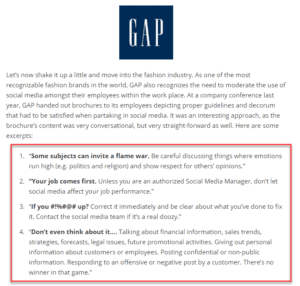Having a social media policy in place is key to ensure that employees are aware of acceptable social media use in the workplace.
Social media allows thoughts, opinions and content to be shared instantaneously, whilst this is great, it can often land workers in hot water!
It is important for companies to monitor what is being said online by employees so you can continue to improve your online brand identity. To ensure your company doesn’t suffer any social media disasters, we want to show you how to write a social media policy for your company.
What is a Social Media Policy?
A social media policy is a code of conduct for employees and staff that provides guidelines on how to act on social media. The expectations are written so that the company that sets the guidelines can continuously monitor behaviour that is aligned with their ethics.
With clear guidelines, companies can assist employees and make them understand how to use social media to promote their brand. Companies can outline best practices for sharing company content on social and how to comment appropriately online.
Benefits
Social media can be a complicated topic for copyright and privacy issues. Strong social media policies can help protect companies against potential legal troubles and security risks. They can outline potential threats and include instructions on how to avoid them.
Companies that have a simple social media policy for employees to follow may have many benefits. If staff love working for the company and want to comment on the brand, then companies can give them the tools to do it in a way that ensures they don’t have to worry about getting on the wrong side of their boss!
Companies need to decide how they want to communicate to the people who often form the front line of public engagement. If the person posting content can understand the direction the company wants to go in, it will work wonders for the company.
Social Media Policy Template Example
Some social media policies are ten pages long with very restrictive regulations, while other policies are quite broad and may only include a page. Companies should include as much detail as they think their business needs to include or as little detail in the set guideline. Below is a template to get you started:
Policy Brief & Purpose
- Explain the importance of this policy to your employees and why they must adhere to the policy.
Mission
- A small explanation on the “why”? For example, “This policy aims to increase professionalism and style across all brand social media platforms”.
Policy Elements
- Explain the different social media channels this policy applies to; social media, blogs, messenger, forums.
Personal Social Media Use
- Can employees access their personal accounts at work?
- Ensure that comments or statements made on a personal account don’t represent your brand. For example, “opinions are my own”.
- Avoid sharing intellectual property.
- Avoid liking, sharing, commenting or posting any offensive, defamatory or derogatory content.
- No online bullying.
Representing a Brand Online
If you have an employee who is managing your Facebook or Instagram account, make sure it is clearly outlined what is expected of them.
- When engaging in conversations online be polite, respectful and patient.
- Avoid discussing topics that fall outside your expertise. Don’t answer a question or make a promise that the brand can’t keep.
- Adhere to laws on copyright, trademarks and plagiarisms.
- Any high-impact content should be discussed with PR or management.
- Avoid liking, sharing, commenting or posting any offensive, defamatory or derogatory content.
- No online bullying.
- Correct or remove false content.
Disciplinary Action
Having a social media policy in place sets clear guidelines and boundaries for both employee and employer. If policy guidelines are not followed you must take the necessary actions that have been outlined to your employee. This can include termination or removal of job tasks.
Examples of not complying with a social media policy can include:
- Ignoring job responsibilities and deadlines because of unacceptable social media use at work.
- Posting confidential information through personal or social media accounts.
- Using offensive comments to users online.
Disclaimer: This policy template is meant to provide some guidelines and should be used as a reference. It is not a legal document.
Check out 5 great examples of Social Media Policies from leading brands; Adidas, Best Buy, Hewlett-Packyard, GAP and The Los Angeles Times.
What next?
Once you have finalised your policy, it needs to be given to all employees so that they can conduct themselves in a professional manner. They should seek input and ask employees for any additional information or issues they wish to discuss.
As social media changes, brand’s will need to constantly update and research new trends and ideas for the policy. Encourage employees to stay active as it can be a great way for companies to position themselves in the digital space.
Be sure to Listen
Check out our post on social listening tools to make sure you are actively involved with your brand’s conversations. We also discuss why you should be using social listening for your brand










LET’S CONNECT